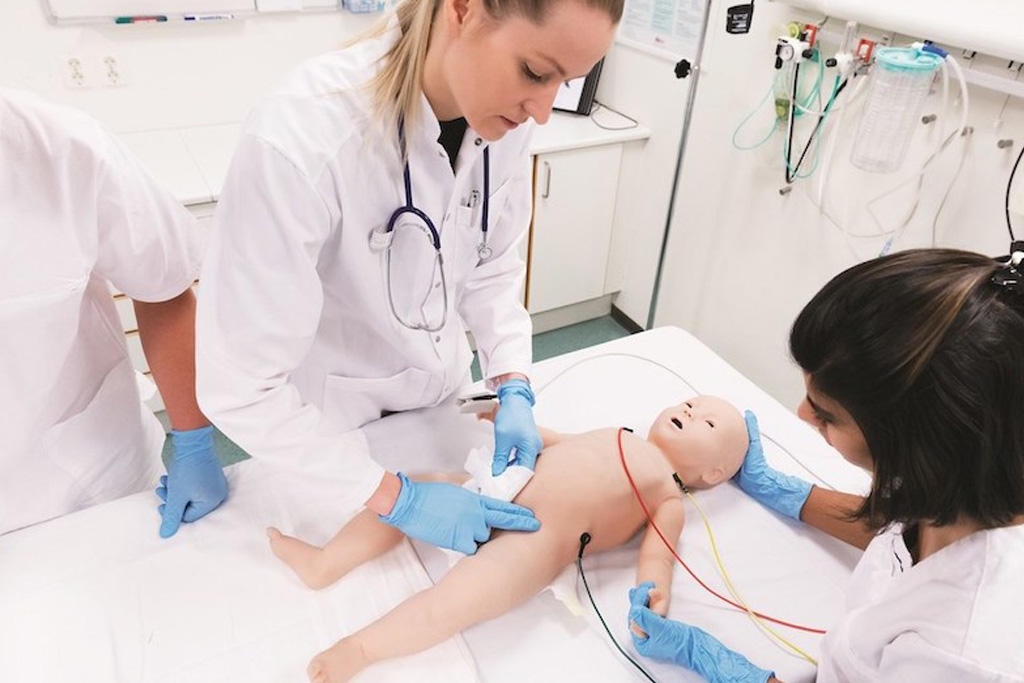How Simulation-Based Training Enhances Pediatric Nurse Education

Students in the nursing lab at John Carroll University are practicing vital skills to save children’s lives.
One “patient” in the educational setting is Aria — a medical manikin (or mannequin) from CAE Healthcare that represents a 7-year-old child and features vocal expressions and sounds, an advanced airway, and neurological and bleeding systems. By mimicking human anatomy and physiology, the manikin allows pediatric-nursing students to develop hands-on clinical skills in a safe way that does not risk harm to actual patients.
Manikins and other simulation equipment have become powerful tools in pediatric-nurse training programs.
Benefits of Simulation-Based Training in Nursing
Simulation-based training is an educational technique that creates realistic scenarios in a controlled environment. It allows future and current nurses to improve their skills and learn from mistakes. Furthermore, nurses can enhance their pediatric assessment skills and advance proficiency in the nursing process — all while reducing anxiety about pediatric care.
Simulation has been enhanced by many high-tech developments. The technology in simulation-based learning is designed to prepare users for cognitive, psychomotor, and affective skills. Being interactive, the training requires face-to-face educational sessions.
In addition to manikins, simulation scenarios and processes can include:
- Partial-task simulators — models (e.g., hands-arms) used to implement a clinical skill or task that can be repeated by students, for example placing an airway or wound suturing.
- Virtual reality — uses computers and standardized patients (virtual patients) to create a realistic learning and evaluation setting.
- E-learning — computer-generated simulators represent tasks or settings used to facilitate learning.
Nursing students use simulation learning experiences to practice, and they receive corrective feedback embedded into a simulator that allows them to become competent. Meanwhile, faculty members evaluate students’ skills, including critical thinking.
Building Skills and Confidence
Competency and confidence are among the personal goals of pediatric-nursing students. In the college lab, practice through simulation manikins allows nursing students to prepare for true-to-life medical situations without fear of performing procedures. The manikins are the closest things to real people with real conditions and injuries.
Importantly, simulation-based education prepares nurses for careers in pediatrics. From infancy through adolescence, children have different stages of development that affect their interactions with nurses. Challenges in pediatric nursing include treating frightened and confused children, inflicting pain on babies and young children, and keeping stressed parents informed and calm.
Infants, in particular, are a special population because pediatric nurses cannot explain procedures to them like they can older children. Nurses must focus on maintaining a steady hand and composure when caring for them. Fortunately, John Carroll University’s nursing students have the advantage of developing the skills to treat babies with the help of Luna, the infant manikin from CAE Healthcare, that enables learners to gain proficiency in newborn assessment, resuscitation, and advanced life support.
Innovative Nurse Training
Indeed, training for nursing pediatric patients presents some challenges and limitations. Innovative strategies like simulation-based learning enhance prelicensure nursing education. Simulation can also promote teamwork and collaboration and the ability to develop a protocol for treating patients.
Advancement in technology allows John Carroll University to deliver meaningful, interactive, and intentional clinical experiences for nursing students that accomplish three objectives:
- enhance their pediatric assessment skills
- reduce their anxiety about pediatric inpatient care
- advance their proficiency in the nursing process
John Carroll University offers a Bachelor of Science in Nursing (BSN) program that features low- and high-fidelity nursing simulation labs, where students learn to practice skills that coincide with classroom lectures and clinical experiences. Specialized courses, such as Obstetrics, Immediate Newborn Care, and Pediatrics, are linked with simulated experiences focusing on nursing care.
Pursue a nursing degree at John Carroll University, a private Jesuit university near Cleveland, Ohio, which offers state-of-the-art clinical training across the region’s three major healthcare systems.
